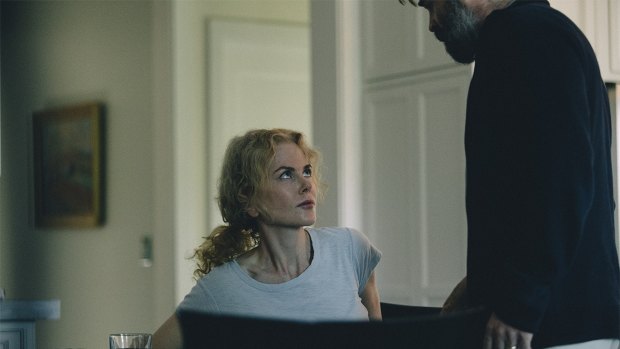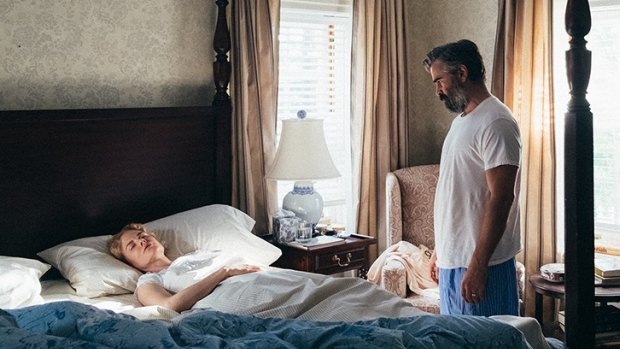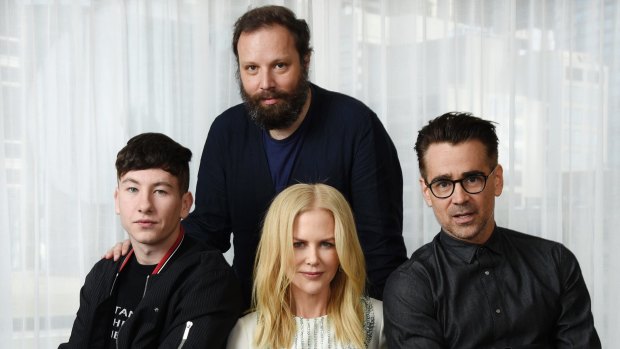Yorgos Lanthimos really doesn't want to be drawn on the whys and wherefores. Why did he choose to make his new film, The Killing of a Sacred Deer, about an evil child? Or is Martin not really evil? Is his plan to wreak death on an entire family a kind of metaphor? (Said slightly desperately, by someone more than usually confused by the Lanthimos way of doing things.) The director most identified with the so-called "Greek weird wave", which rose in parallel with his benighted country's financial crisis, certainly isn't going to start dissecting metaphors. "I don't like explaining what we are doing," he says, "because I've discovered I don't really know."
Lanthimos sprang on to the world stage with Dogtooth (2009), a bizarrely unsettling but funny story of a well-to-do Greek family whose paterfamilias has persuaded them that the world outside the walls of their house is dangerous, ensuring they will never know otherwise by blocking out electronica as well as visitors. Among a list of more familiar names, it was nominated for an Oscar as best foreign film. Alps (2011) was about a business that hired out people to impersonate the dead in order to soften the blow felt by the suddenly bereaved. With The Lobster (2015), he swapped into English, which he speaks perfectly. It was an international arthouse hit and won an Oscar nomination for best script.
The Lobster centred on a halfway house for those who found themselves without partners; either they had to re-partner within a month or be turned into an animal of their choice. In English – delivered in flat, deadpan tones that Sacred Deer star Barry Keoghan calls "the Yorgos way" – the weird wave turned out to sound even weirder. Which makes Lanthimos and his collaborators some of the most exciting, vital filmmakers at work right now; actors and critics jump at the chance to enter his world.
"Like Michael Haneke with a better joke book," as one London reviewer wrote in his review of The Killing of a Sacred Deer, adding with relish that seeing it for the second time several months after its Cannes premiere had made it no clearer.

Nicole Kidman was eager to work with Yorgos Lanthimos after seeing his 2009 film Dogtooth.
The Killing of a Sacred Deer introduces us to a picture-perfect family in Cincinnati. Steven, played by Colin Farrell, is a surgeon. His wife Anna, played by Nicole Kidman, is an ophthalmologist. They have two attractive, clever children (Raffey Cassidy and Sunny Suljic) and an attractive, clever dog. Yet there is something chilling in their Stepford-style politeness over the dinner table, something even more disquieting in the couple's sexual routines – "General anaesthetic?" asks Anna rhetorically as she lies back and pretends to be unconscious – and something very odd indeed about Steven's friendship with Martin. Martin – played by Keoghan – is a teenage boy from the other side of the tracks; he is twitchy, shifty and awkward even by the standard of adolescent boys.
We soon learn that Martin's father died on Steven's operating table, and has since been taken under his wing. He won't admit guilt or negligence, but he does buy the boy substantial gifts. Martin has another purpose, however. His working-class family is now truly poor; his mother (Alicia Silverstone) desperately misses having a man in her life; his dad was young and should not have died.
So it is only fair, he reasons, that someone in Steven's family should die as compensation. Steven can and must choose which one. If he doesn't, they will all die anyway: one by one, they will fall victim to paralysis, starvation and bleeding eyes. His fault, his choice! The title draws on the Greek and Etruscan myth of Iphigenia, killed by her own father Agamemnon to appease the goddess Artemis after he kills one of her deer. Lanthimos leaves us to work out that parallel for ourselves.
Lanthimos was curious, he says, about the idea of a choice that was really no choice at all. "I was interested in justice and revenge and choices in facing dilemmas that seem impossible to answer, where you feel you couldn't make a decision if you were in that person's shoes," he says. "I think that is quite an interesting feeling to experience."

The Killing of a Sacred Deer stars Nicole Kidman and Colin Farrell as a couple engaged in disturbing sexual routines.
He and his regular script writer, Efthymis Filippou, built the story from there; scraps of ideas coalesced into scenes and then a storyline. They liked the idea of a teenager taking control over authoritative adults. They liked the idea of the victim being a doctor because the question of blame is so blurry. "This is someone who has people's lives in his hands every day," says Lanthimos. "It is very ambiguous whether he is to blame if he tried to help someone and something goes wrong. Or whether he is to blame if he's a good doctor or not. It just makes it more complex."
Nicole Kidman was one of those who were eager to work with Lanthimos after Dogtooth and told him so. She read an early version of The Killing of a Sacred Deer and immediately wrote to say she wanted to do it. She was initially thrown by his refusal to discuss story, character or backstory. During takes, the most he would suggest would be "faster" or "too loud".

From left, Barry Keoghan, Yorgos Lanthimos, Nicole Kidman and Colin Farrell during the Toronto International Film Festival.Credit: AP
"You ask him a question and he goes 'erm'. And he would use his eyes. I would look into his eyes, he would raise his eyebrows and that would be my note. But it's very freeing, actually. It takes everything away. Any sense of urgency or that desire to please: all of that evaporates, which is a good place to work from."
Instead of discussing psychological motivations, Lanthimos would get the cast to play games. "Silly things that don't necessarily seem directly related to the situation, so we don't have in mind what it means," he says. The atmosphere is light-hearted. He says he tries to be open both to whatever the actors bring with them – "It's important that I don't try to make them into something I've imagined" – and circumstances. "The place, the situation, the atmosphere, the weather. I try not to control those things too much."
Before The Lobster, he even avoided using music. "I thought music made it much more specific, much more one thing, most of the time; you could be much more ambiguous when you were free of it."
What he realised was that he could create a greater sense of enigma by using music that was ostensibly mismatched. "I started juxtaposing music to scenes that had seemingly a very different feel ... which set a new tone for me. Again in this film, I tried to discover what sound that would be." Ligeti stands out in a largely classical soundtrack.
Lanthimos' earlier films were witheringly absurdist, but The Killing of a Sacred Deer is many shades darker: it recalls the Theatre of Cruelty. Kidman says he kept reminding them that it was supposed to be a comedy. "He did, yeah," agrees Keoghan. "To play with our heads. But I think that was to take the acting thing away. He didn't want any thought going into what we were saying, basically: the lines say it all." So is it a comedy? "I don't know," Keoghan says. "With Yorgos' films, you can't picture what they are. They're their own genre. It's the Yorgos way."
The Killing of a Sacred Deer opens on November 16.